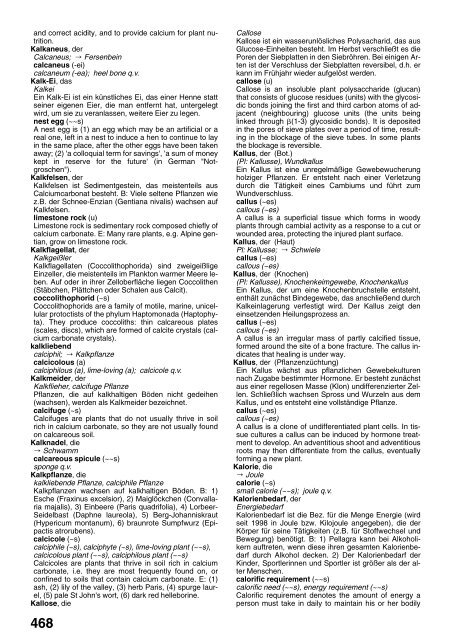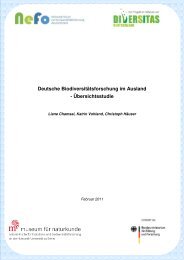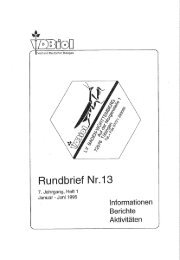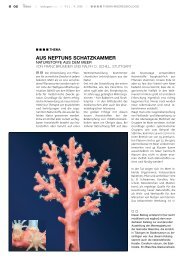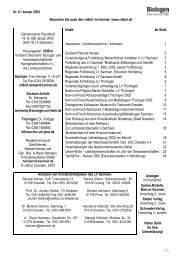Beispieldatei 1. Auflage BILI - VBio
Beispieldatei 1. Auflage BILI - VBio
Beispieldatei 1. Auflage BILI - VBio
Sie wollen auch ein ePaper? Erhöhen Sie die Reichweite Ihrer Titel.
YUMPU macht aus Druck-PDFs automatisch weboptimierte ePaper, die Google liebt.
and correct acidity, and to provide calcium for plant nutrition.<br />
Kalkaneus, der<br />
Calcaneus; ? Fersenbein<br />
calcaneus (-ei)<br />
calcaneum (-ea); heel bone q.v.<br />
Kalk-Ei,das<br />
Kalkei<br />
Ein Kalk-Ei ist ein künstliches Ei, das einer Henne statt<br />
seiner eigenen Eier, die man entfernt hat, untergelegt<br />
wird, um sie zu veranlassen, weitere Eier zu legen.<br />
nest egg (~~s)<br />
A nest egg is (1) an egg which may be an artificial or a<br />
real one, left in a nest to induce a hen to continue to lay<br />
in the same place, after the other eggs have been taken<br />
away; (2) ©a colloquial term for savings©, ©a sum of money<br />
kept in reserve for the future© (in German "Notgroschen").<br />
Kalkfelsen, der<br />
Kalkfelsen ist Sedimentgestein, das meistenteils aus<br />
Calciumcarbonat besteht. B: Viele seltene Pflanzen wie<br />
z.B. der Schnee-Enzian (Gentiana nivalis) wachsen auf<br />
Kalkfelsen.<br />
limestone rock (u)<br />
Limestone rock is sedimentary rock composed chiefly of<br />
calcium carbonate. E: Many rare plants, e.g. Alpine gentian,<br />
grow on limestone rock.<br />
Kalkflagellat, der<br />
Kalkgeiûler<br />
Kalkflagellaten (Coccolithophorida) sind zweigeiûlige<br />
Einzeller, die meistenteils im Plankton warmer Meere leben.<br />
Auf oder in ihrer Zelloberfläche liegen Coccolithen<br />
(Stäbchen, Plättchen oder Schalen aus Calcit).<br />
coccolithophorid (~s)<br />
Coccolithophorids are a family of motile, marine, unicellular<br />
protoctists of the phylum Haptomonada (Haptophyta).<br />
They produce coccoliths: thin calcareous plates<br />
(scales, discs), which are formed of calcite crystals (calcium<br />
carbonate crystals).<br />
kalkliebend<br />
calciphil; ? Kalkpflanze<br />
calcicolous (a)<br />
calciphilous (a), lime-loving (a); calcicole q.v.<br />
Kalkmeider, der<br />
Kalkflieher, calcifuge Pflanze<br />
Pflanzen, die auf kalkhaltigen Böden nicht gedeihen<br />
(wachsen), werden als Kalkmeider bezeichnet.<br />
calcifuge (~s)<br />
Calcifuges are plants that do not usually thrive in soil<br />
rich in calcium carbonate, so they are not usually found<br />
on calcareous soil.<br />
Kalknadel, die<br />
? Schwamm<br />
calcareous spicule (~~s)<br />
sponge q.v.<br />
Kalkpflanze,die<br />
kalkliebende Pflanze, calciphile Pflanze<br />
Kalkpflanzen wachsen auf kalkhaltigen Böden. B: 1)<br />
Esche (Fraxinus excelsior), 2) Maiglöckchen (Convallaria<br />
majalis), 3) Einbeere (Paris quadrifolia), 4) Lorbeer-<br />
Seidelbast (Daphne laureola), 5) Berg-Johanniskraut<br />
(Hypericum montanum), 6) braunrote Sumpfwurz (Epipactis<br />
atrorubens).<br />
calcicole (~s)<br />
calciphile (~s), calciphyte (~s), lime-loving plant (~~s),<br />
calcicolous plant (~~s), calciphilous plant (~~s)<br />
Calcicoles are plants that thrive in soil rich in calcium<br />
carbonate, i.e. they are most frequently found on, or<br />
confined to soils that contain calcium carbonate. E: (1)<br />
ash, (2) lily of the valley, (3) herb Paris, (4) spurge laurel,<br />
(5) pale St John©s wort, (6) dark red helleborine.<br />
Kallose,die<br />
468<br />
Callose<br />
Kallose ist ein wasserunlösliches Polysacharid, das aus<br />
Glucose-Einheiten besteht. Im Herbst verschlieût es die<br />
Poren der Siebplatten in den Siebröhren. Bei einigen Arten<br />
ist der Verschluss der Siebplatten reversibel, d.h. er<br />
kann im Frühjahr wieder aufgelöst werden.<br />
callose (u)<br />
Callose is an insoluble plant polysaccharide (glucan)<br />
that consists of glucose residues (units) with the glycosidic<br />
bonds joining the first and third carbon atoms of adjacent<br />
(neighbouring) glucose units (the units being<br />
linked through b(1-3) glycosidic bonds). It is deposited<br />
in the pores of sieve plates over a period of time, resulting<br />
in the blockage of the sieve tubes. In some plants<br />
the blockage is reversible.<br />
Kallus, der (Bot.)<br />
(Pl: Kallusse), Wundkallus<br />
Ein Kallus ist eine unregelmäûige Gewebewucherung<br />
holziger Pflanzen. Er entsteht nach einer Verletzung<br />
durch die Tätigkeit eines Cambiums und führt zum<br />
Wundverschluss.<br />
callus (~es)<br />
callous (~es)<br />
A callus is a superficial tissue which forms in woody<br />
plants through cambial activity as a response to a cut or<br />
wounded area, protecting the injured plant surface.<br />
Kallus, der (Haut)<br />
Pl: Kallusse; ? Schwiele<br />
callus (~es)<br />
callous (~es)<br />
Kallus, der (Knochen)<br />
(Pl: Kallusse), Knochenkeimgewebe, Knochenkallus<br />
Ein Kallus, der um eine Knochenbruchstelle entsteht,<br />
enthält zunächst Bindegewebe, das anschlieûend durch<br />
Kalkeinlagerung verfestigt wird. Der Kallus zeigt den<br />
einsetzenden Heilungsprozess an.<br />
callus (~es)<br />
callous (~es)<br />
A callus is an irregular mass of partly calcified tissue,<br />
formed around the site of a bone fracture. The callus indicates<br />
that healing is under way.<br />
Kallus, der (Pflanzenzüchtung)<br />
Ein Kallus wächst aus pflanzlichen Gewebekulturen<br />
nach Zugabe bestimmter Hormone. Er besteht zunächst<br />
aus einer regellosen Masse (Klon) undifferenzierter Zellen.<br />
Schlieûlich wachsen Spross und Wurzeln aus dem<br />
Kallus, und es entsteht eine vollständige Pflanze.<br />
callus (~es)<br />
callous (~es)<br />
A callus is a clone of undifferentiated plant cells. In tissue<br />
cultures a callus can be induced by hormone treatment<br />
to develop. An adventitious shoot and adventitious<br />
roots may then differentiate from the callus, eventually<br />
forming a new plant.<br />
Kalorie,die<br />
? Joule<br />
calorie (~s)<br />
small calorie (~~s); joule q.v.<br />
Kalorienbedarf, der<br />
Energiebedarf<br />
Kalorienbedarf ist die Bez. für die Menge Energie (wird<br />
seit 1998 in Joule bzw. Kilojoule angegeben), die der<br />
Körper für seine Tätigkeiten (z.B. für Stoffwechsel und<br />
Bewegung) benötigt. B: 1) Pellagra kann bei Alkoholikern<br />
auftreten, wenn diese ihren gesamten Kalorienbedarf<br />
durch Alkohol decken. 2) Der Kalorienbedarf der<br />
Kinder, Sportlerinnen und Sportler ist gröûer als der alter<br />
Menschen.<br />
calorific requirement (~~s)<br />
calorific need (~~s), energy requirement (~~s)<br />
Calorific requirement denotes the amount of energy a<br />
person must take in daily to maintain his or her bodily


